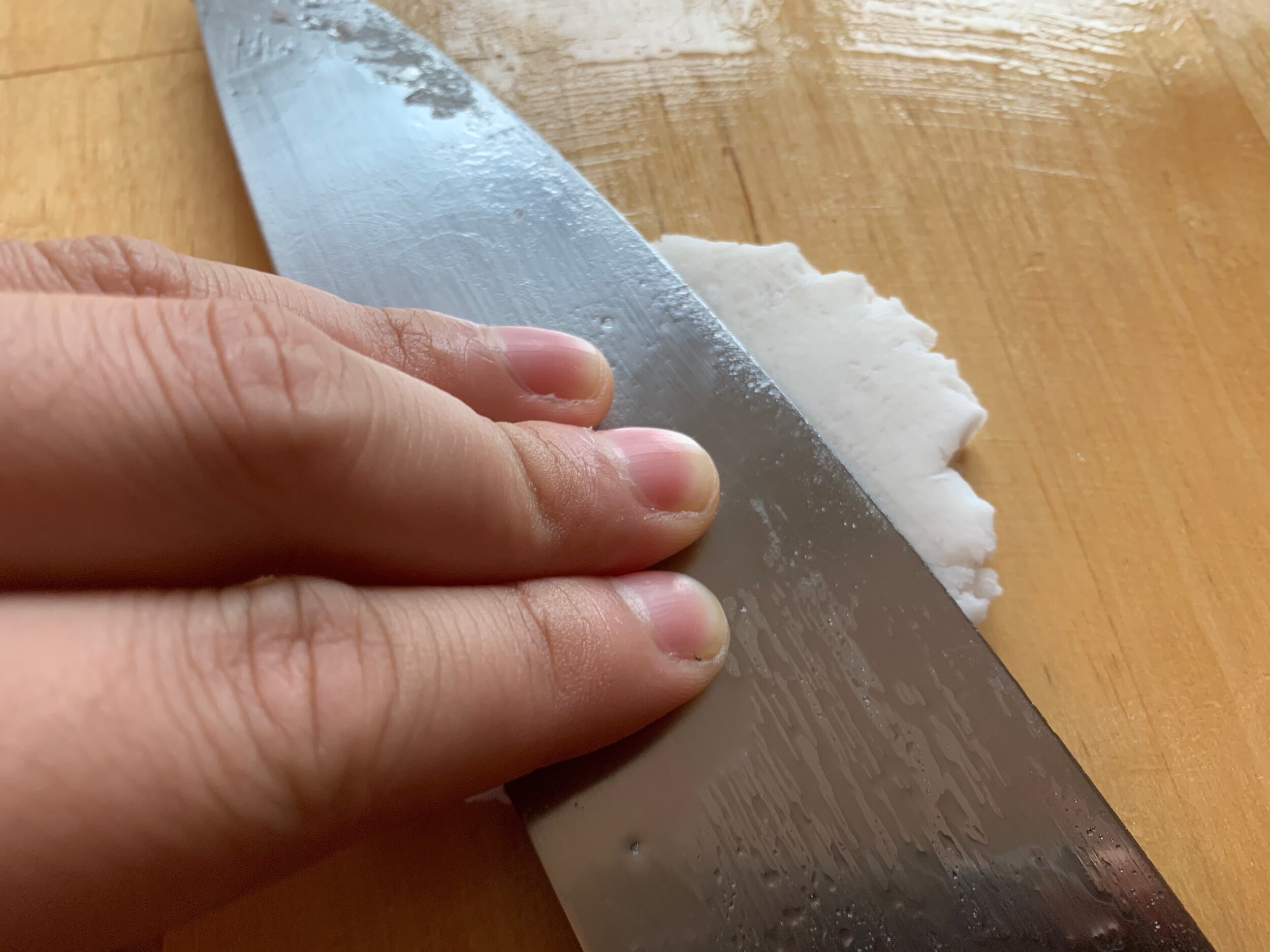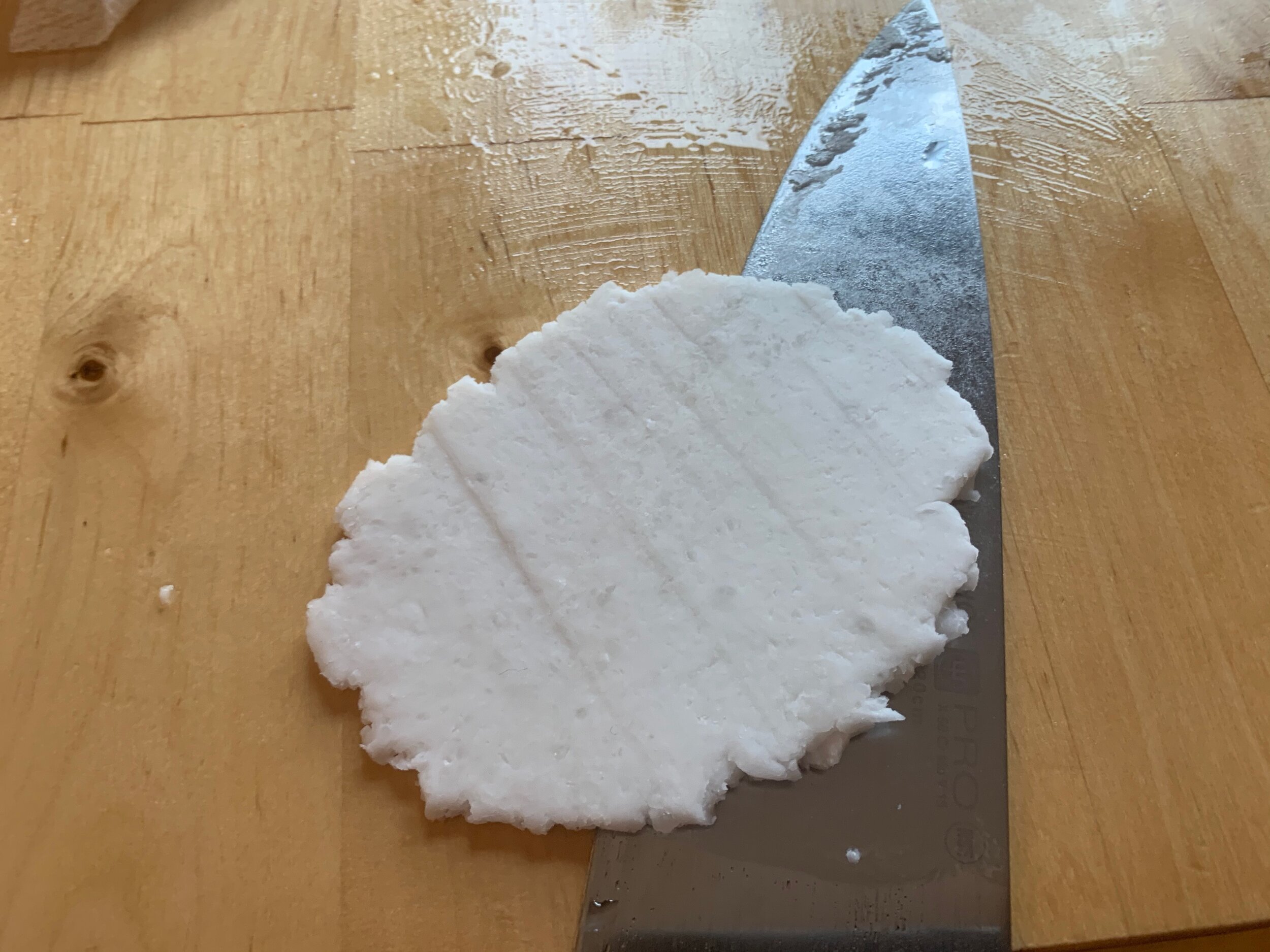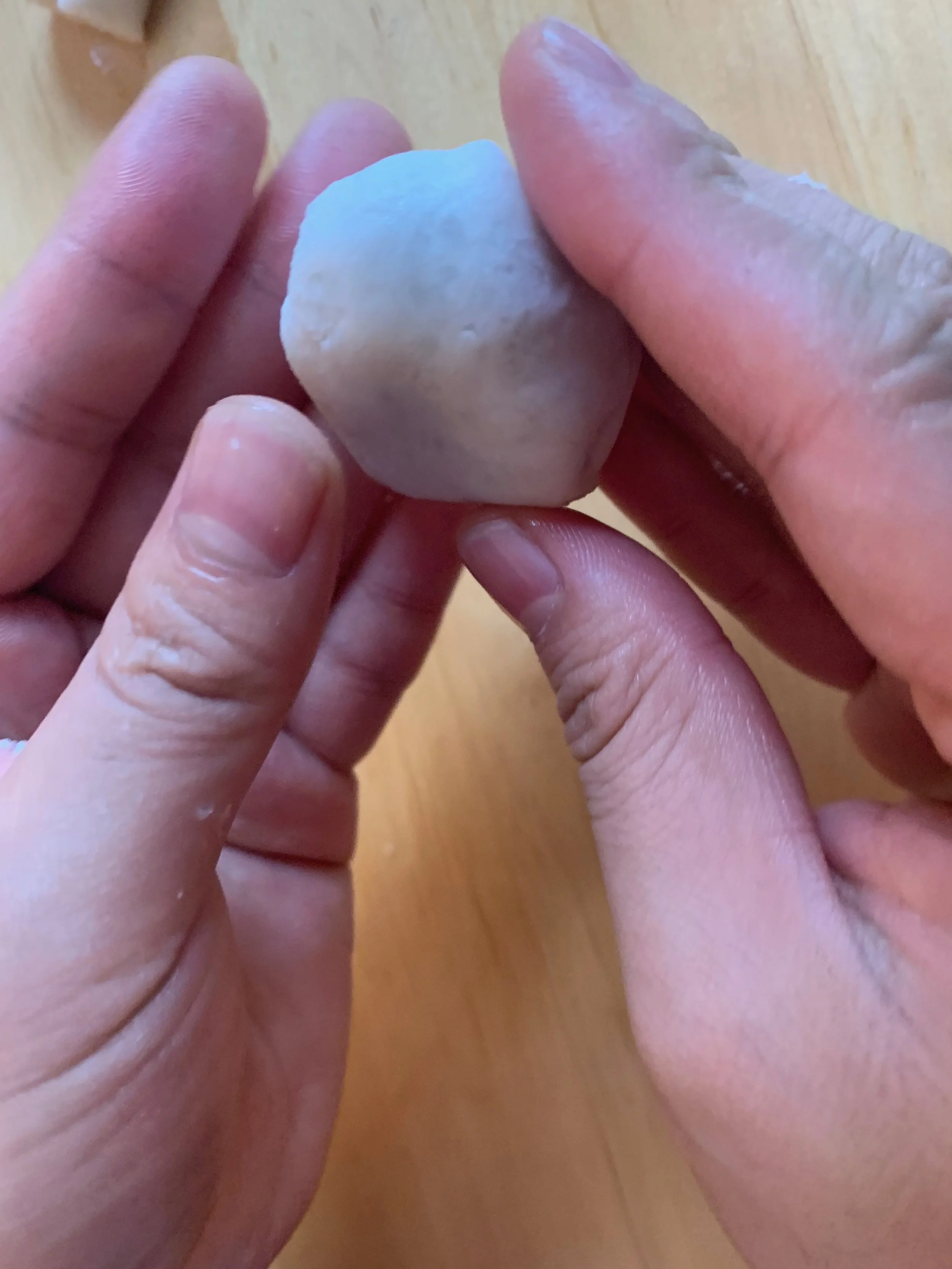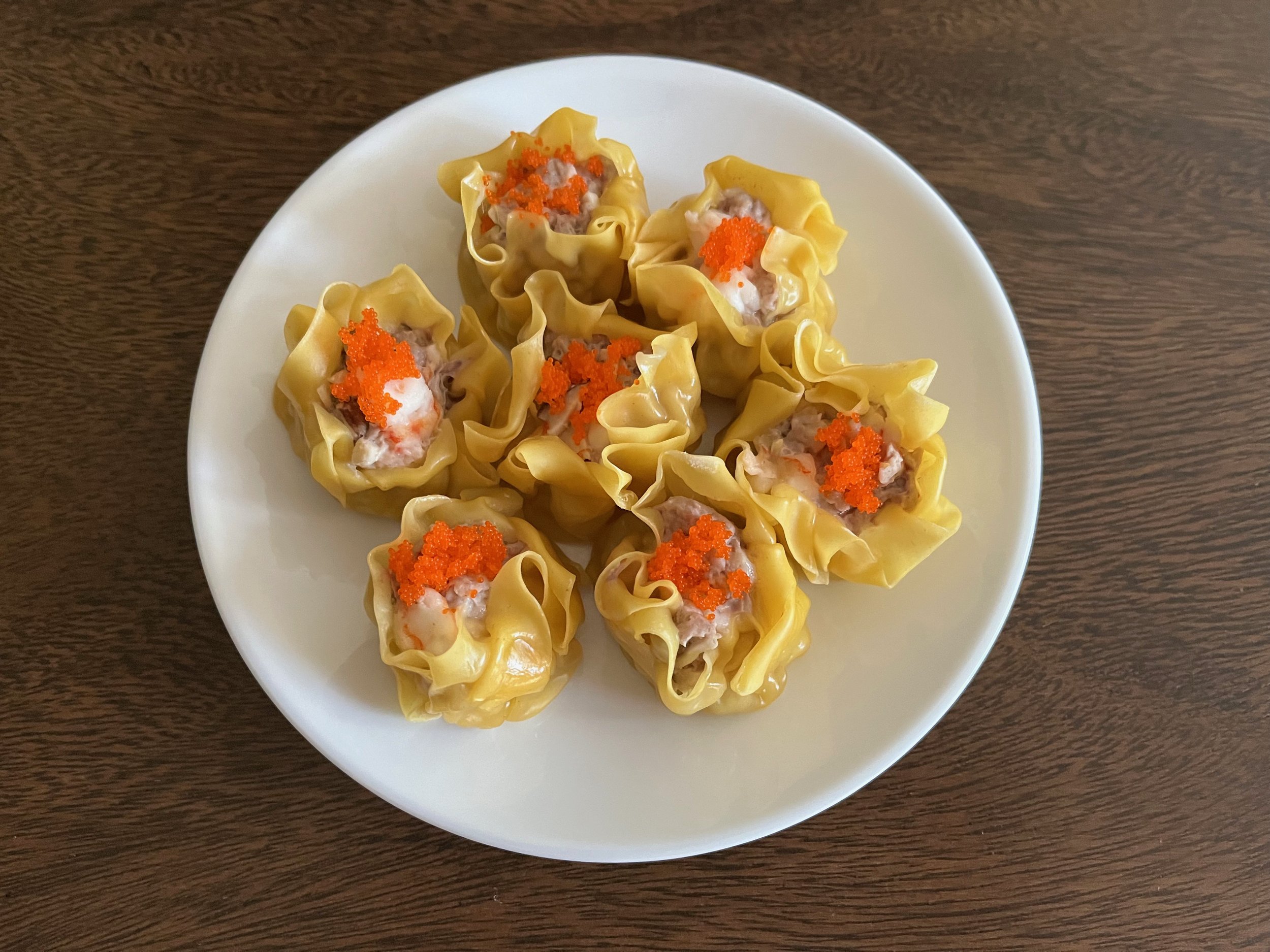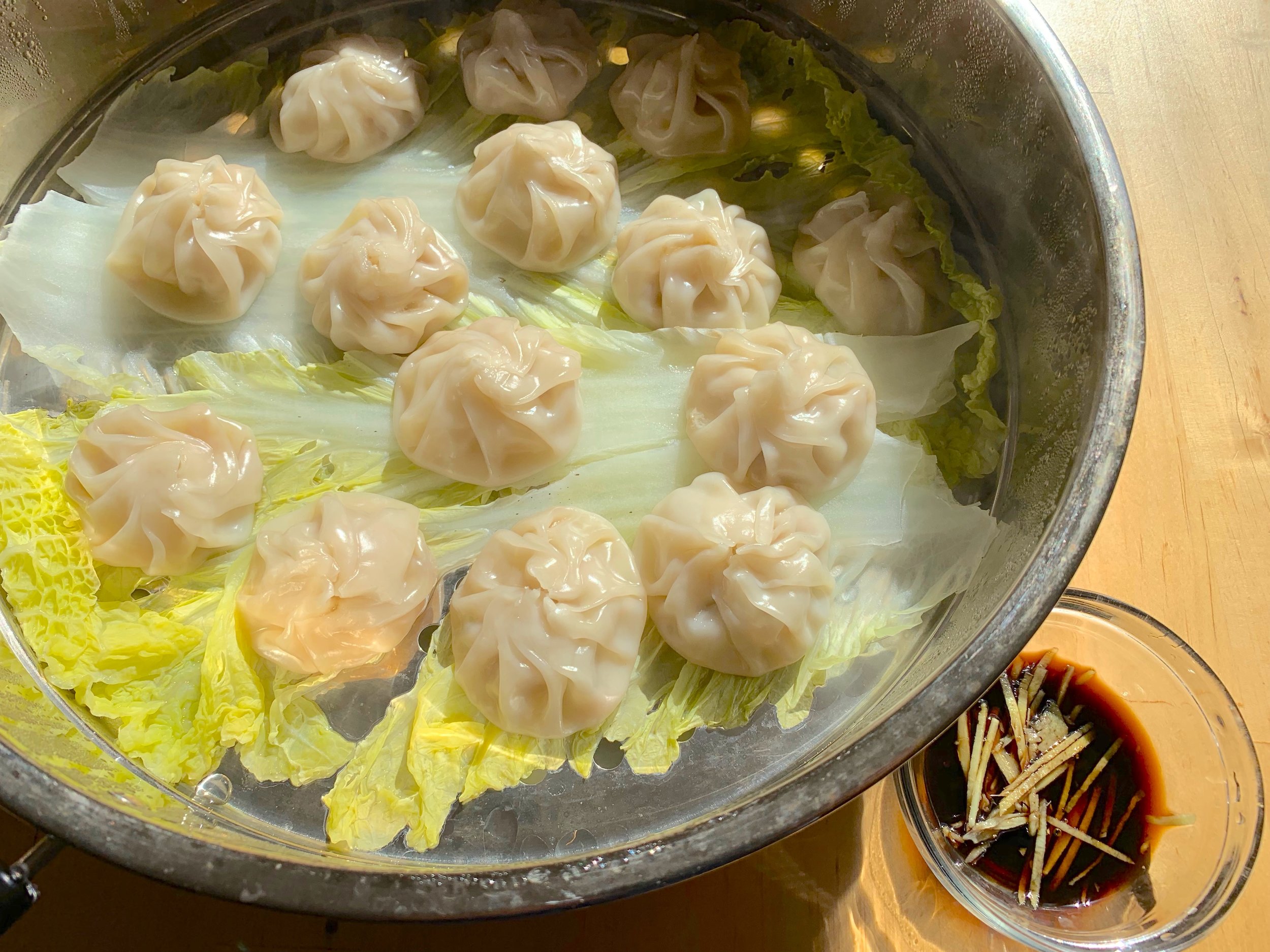Shrimp and Chive Crystal Dumplings

韭菜餃 (Jiu Tsai Jiao)
Shrimp and chive crystal dumplings are one of our favorite dim sum items—pairing shrimp and garlic chives makes for an intensely savory filling. These dumplings use the same translucent dough as har gow, but are pan-fried for a crisp exterior!
Ingredients
For the Wrappers
1 cup wheat starch
½ cup tapioca flour
¼ tsp salt
1½ tbsp shortening or lard
¾ cup boiling water
Vegetable oil
The trickiest part of making these dumplings is the translucent crystal skins. The dough for the dumplings is made of wheat starch and tapioca flour. [1] Most doughs are held together by gluten, a family of proteins which polymerize to provide structure and elasticity. Unlike wheat flour, however, neither wheat starch nor tapioca flour contain any gluten. Instead, starch-based doughs rely entirely on starch gelatinization to come together. Gelatinization of starch occurs in the presence of water and heat, so to make the dough we must employ boiling water, and work quickly to hydrate the starch before the heat dissipates. The resulting dough can be sticky and will not stretch, both of which make forming the wrappers difficult. Here’s how to do it.
Begin by combining the tapioca flour, wheat starch, and ¼ tsp salt in a large bowl and mixing the dry ingredients together. Bring some water to a boil on the stovetop. When working with starch-based doughs, I prefer boiling the water myself, rather than relying on water from a hot water dispenser or instant kettle. This is because the water from these sources is often below 100° C, and we really want every bit of heat we can muster from a given volume of water when trying to bring together a dough using gelatinization alone. Measure ¾ cup of the boiling water, and slowly pour the water into the starch, stirring rapidly and continuously with chopsticks or a fork. Continue mixing until the starch begins to clump up and turn translucent.
As the dough starts to come together, introduce the shortening or lard in about teaspoon-size pieces. Mix until the shortening melts and is incorporated. When the dough becomes too stiff to mix, knead the dough with clean hands for 2 to 3 minutes, or until it becomes smooth and uniform. Since there is no gluten, kneading doesn’t serve any structural function in this dough—it just helps combine the lumps of gelatinized starch into one uniform mass.
Once the dough is smooth, cover with plastic wrap so the dough retains its moisture, and set aside. This dough cannot be refrigerated, and also cannot sit for too long. Once it dries out it will crack and cannot be used to make wrappers.
Ingredients
For the Filling
1/3 lb shrimp
4 oz garlic chives, finely chopped
¼ tsp salt
¼ tsp white pepper
1 tsp cornstarch
½ tsp sesame oil
With the dough done, let’s move onto the filling. Mince your peeled and cleaned shrimp, finely chop the garlic chives, and combine them in a bowl together with ¼ teaspoon salt, ¼ teaspoon white pepper, 1 teaspoon cornstarch (to help bind the filling together), and ½ teaspoon sesame oil. Mix the filling until uniform.
Once the filling is ready, set up your workstation for wrapping the dumplings. One bowl should contain your dough, still covered in plastic wrap. A second bowl will contain your filling, with a spoon standing by. Have a plate lined with plastic wrap or parchment paper standing by for you to place your completed dumplings. The dough will stick, so liberally grease your work surface with a vegetable oil-soaked paper towel. We will also need a knife with a wide blade (ideally a cleaver, but a broad chef’s knife will work too) to press the wrappers. This blade will also have to be oiled. Keep additional oil nearby if you need to re-grease the blade during the wrapping process. To keep the dough from sticking to your hands and fingers, oil your fingers as well.
Because the dough will dry out quickly, the best workflow is to make one wrapper and then fill it immediately, forming the dumpling before making the next wrapper. The dough should yield 24 wrappers in total. Divide the dough ball into 4 equal pieces, and return 3 of the pieces to the covered bowl for later. Roll the piece of dough into a cylinder with your hands, then cut it into 6 equal pieces with a greased knife.
To make a wrapper, begin by using your palm to carefully flatten one of these small dough pieces into a circular puck about 1 inch in diameter. Because the dough contains no gluten, it cannot be rolled thin without tearing. Instead, we will form the wrapper by pressing, similar to the way a tortilla is made (incidentally, if you have a tortilla press it is a great tool for making these dumpling wrappers).
Place the dough puck on your greased work surface, and press down on the puck with the flat of your greased knife. Use the fingers of your non-dominant hand to help press the blade down, applying equal pressure on the dough. Equal pressure is much more important than total pressure. The dough is soft and does not need a lot of force to flatten, and if you apply too much pressure you risk losing control of the knife. Press the dough a few times, moving the knife as necessary to create a flat wrapper about 3 inches in diameter and 1/16th of an inch thick. The thinner you can get the wrapper, the better—as long as no holes or tears appear. To release the wrapper from your work surface, swiftly sweep the blade of the knife under the wrapper.
Scoop about 1 tablespoon of filling into the middle of the wrapper. Pinch the two sides of the wrapper together in the middle, then carefully bring the rest of the edges together, pinching them together and smoothing the seams with your hands to form a fat cylindrical shape about an inch and a half in diameter. Remember that the crystal skin dough is not elastic, so work gently when wrapping. Be sure that there’s no air inside the dumpling, which can expand and burst the skin of the dumpling when it is cooking. Set the completed dumpling on the lined plate, and repeat until all 24 dumplings are finished.
You can fry these dumplings immediately, or you can freeze them by placing your parchment or plastic wrap lined plate into the freezer. After 6 hours or so, the dumplings should be rock solid. Transfer into a zipper storage bag for storage in the freezer.
To Cook
We will use a method similar to potstickers to cook these dumplings, which involves both frying and steaming. Because of how sticky and delicate the wrappers is, we recommend using a nonstick pan. Heat about 1 tablespoon of vegetable oil in the pan over medium heat. When the oil is hot, add the dumplings seam side down. Fry the dumplings for about 1 minute to help seal the dumpling, then add ½ cup water to the pan and cover immediately. This water will steam the dumplings and help them cook. Keep the pan covered until all the water has evaporated, about 5 minutes. At this point, the dumplings should be fully translucent—if not, add a bit more water and keep steaming. When the water is fully evaporated, fry the dumplings for two minutes on each side, or until the exterior is lightly golden and crisp. Serve immediately, with some chili garlic sauce for dipping.
Substitutions
Some versions of this dumpling will use fish paste in lieu or in addition to the shrimp. To make a vegetarian version, substitute the shrimp for some scrambled eggs and vermicelli noodles.
[1] What’s the difference between wheat flour and wheat starch? Flour is made by grinding the wheat grain, and thus contains carbohydrates, fiber, fat, and protein (including gluten). Wheat starch (and most other food-grade starches, such as cornstarch) is made by first grinding up the grains, then adding water to form a slurry. Only the carbohydrates are water soluble, with the proteins, fiber, and fat falling out of solution. The sediment is removed and the water is then evaporated, leaving pure starch.
Recipe
Prep Time: 1 hr 20 min Cook Time: 10 min Total Time: 1 hr 30 min
Difficulty: 5/5
Heat Sources: 1 burner
Equipment: pot, large knife, nonstick pan
Servings: 24 dumplings
Ingredients
For the Wrappers
1 cup wheat starch
½ cup tapioca flour
¼ tsp salt
1½ tbsp shortening or lard
¾ cup boiling water
Vegetable oil
For the Filling
1/3 lb shrimp
4 oz garlic chives, finely chopped
¼ tsp salt
¼ tsp white pepper
1 tsp cornstarch
½ tsp sesame oil
Instructions
1. To make the dough for the wrappers, first combine the wheat starch, tapioca flour, and ¼ tsp salt in a large bowl. Mix the dry ingredients together.
2. Bring some water to a boil on the stovetop. Slowly add ¾ cup boiling water to the dry ingredients, stirring rapidly.
3. When the dough looks translucent and is beginning to come together, begin to add the shortening or lard in pieces.
4. Knead the dough for 2-3 minutes, until it becomes smooth. Cover with plastic wrap so the dough retains its moisture.
5. To make the filling, begin by mincing the shrimp and finely chopping the chives.
6. In a large bowl, combine the shrimp, chives, ¼ tsp salt, ¼ tsp white pepper, cornstarch, and sesame oil, and mix until uniform.
7. Before we make the wrappers, prepare your workstation with your covered dough bowl, filling bowl, and a plastic wrapped plate for the completed dumplings. Because the dough dries out quickly, it is best to make a wrapper, fill it, set the completed dumpling aside, and then move on to the next one.
8. Using vegetable oil, liberally grease your hands, your work surface, as well as the blade of a wide knife. Keep additional oil nearby for re-greasing if necessary.
9. The dough should yield 24 wrappers in total. To begin, divide the dough ball into quarters, returning 3 of the quarters to the covered bowl. With your hands, roll the quarter of dough into a cylinder, then cut into 6 equal pieces with a greased knife.
10. To make a wrapper, flatten a piece of dough into a circular puck with your hands. Then, press down on the dough with the flat of your knife, using the fingers of your non-dominant hand to apply even pressure along the blade. Continue pressing, moving the blade as necessary, until the dough forms a rough circle about 3 inches in diameter and 1/16th of an inch thick.
11. Sweep the blade of your knife under the wrapper to release it from your work surface.
12. To wrap, place about 1 tablespoon of filling in the center of the wrapper. Carefully gather and pinch the edges together, working the dumpling between your palms to form a cylindrical shape.
13. Repeat steps 9-12 until all dumplings are completed. Cook immediately, or freeze.
To Cook
1. Heat 1 tbsp vegetable oil in a nonstick pan over medium heat. When the oil is hot, add the dumplings seam side down.
2. Fry for 1 minute to help seal the dumpling, then add ½ cup water to the pan and cover immediately. Keep covered until all of the water has evaporated, about 5 minutes.
3. Remove the lid and fry on each side for 2 minutes.


















